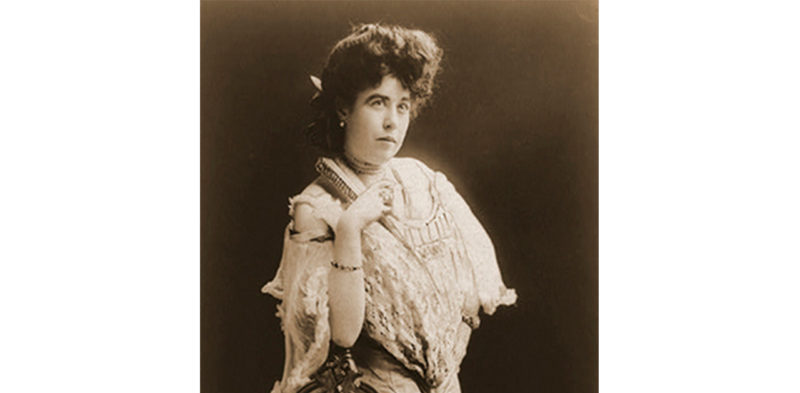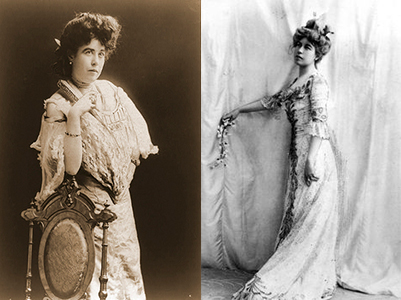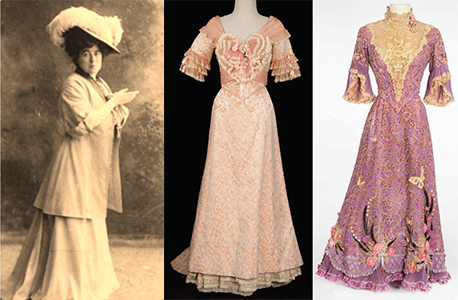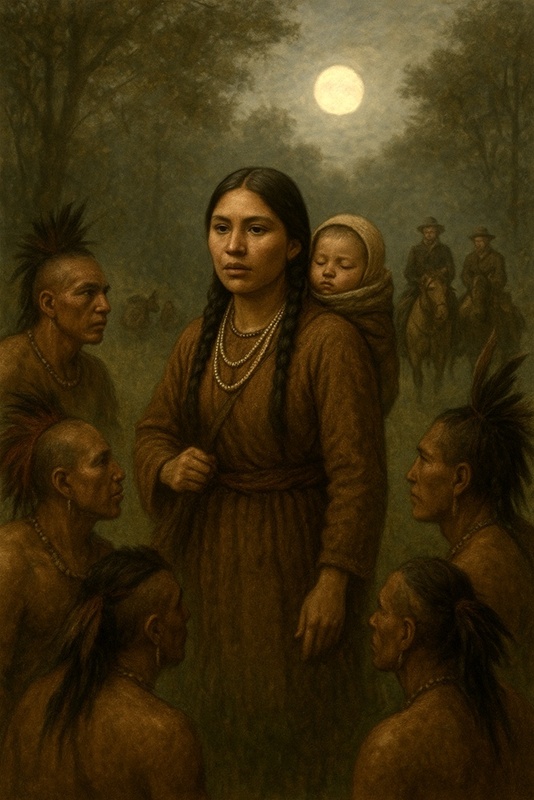The name is Margaret Brown – The Unsinkable Molly Brown is a Myth
Margaret Brown, popularly known as Molly Brown, was never addressed as Molly by anyone who knew her personally. She was known as Maggie to her family until she married. Molly is the creation of legend and Hollywood. Margaret, the flesh and blood woman, was a pioneer in many ways.
Her parents, John and Johanna (Collins) Tobin, were Irish immigrants who came to the United States after the first wave of the Industrial Revolution. Each was widowed with one child when they married and settled into a cottage near the Mississippi River in Hannibal, Missouri. Together, they had four more children. Margaret was the second child of this union. She was born on July 18, 1867.
Margaret’s parents held progressive views, which shaped her thinking and her life. They supported freedom, equality and valued education for all of their children. Margaret attended school until the age of 13 at her aunt, Mary O’Leary’s grammar school. The things she learned from her parents and at school remained a part of her throughout her life. She lived a purposeful life filled with personal growth and a commitment to be an active member of society.
According to the Encyclopedia Titanica, Margaret Brown was a member of the working class who, as a teenager, “worked stripping tobacco leaves at Garth’s Tobacco Company in Hannibal” to help support her family. Long hours, low wages, and work insecurity shaped the lives of many of those around her, including her father, who worked at the Hannibal Gas Works. The longing for a better life led her west to Leadville, Colorado, in the mid-1880s.
Life Begins in Leadville
Margaret’s sister, Mary, and Mary’s new husband, Jack Landrigan, followed the great migration west, accompanied by Margaret and their brother, Daniel Tobin. The Landrigans established a blacksmith shop. Daniel worked in the silver mines, and Margaret, who was known as Maggie at this time, worked in the Carpet and Draperies department of Daniels and Fisher Mercantile where she sewed carpets and drapes.
Not long after arriving in Leadville, Margaret met a mining engineer named James Joseph (“J.J.”) Brown, and the couple wed on September 1, 1886. They started life together at J.J.’s cabin in Stumpftown, a predominantly Irish town located up the hill from Leadville. There first child, Lawrence Palmer was born at the cottage. They soon outgrew the cottage and the family purchased a home in Leadville. Their second child, Catherine Helen was born there in 1889.
Margaret’s early education and her parent’s progressive ideas lead Margaret to be a community organizer from the time her children were very young. She was part of the early feminist movement in Leadville and was instrumental in the formation of the Colorado Chapter of the National American Women’s Suffrage Association. Leadville experienced a deep depression in 1893 due to the repeal of the Sherman Silver Purchase Act, which artificially propped up the price of silver. Unemployment was as high as 90 percent. J.J. thought there could be gold waiting to be found in the mines, and after thoroughly researching the possibilities, developed a timber-and-hay bale method that allowed for excavation to the depths where gold was, indeed, found. Encyclopedia Titanica tells us that by October, “the Little Jonny mine was shipping 135 tons of ore per day, and Brown was awarded 12,500 shares of stock and a seat on the board.” The Browns were now wealthy.
Margaret Brown Hits Her Stride
The Brown family moved to Denver in 1894, where Margaret continued her activism, which was now mixed with philanthropy. According to Encyclopedia Titanica, some of her accomplishments are:
“a founding member of the Denver Women’s Club, which was part of a network of clubs that advocated literacy, education, suffrage, and human rights in Colorado and throughout the United States
raised funds to build the Cathedral of Immaculate Conception as well as St. Joseph’s Hospital
worked with Judge Ben Lindsey to help destitute children and establish the first juvenile court in the country (the basis for today’s U.S. juvenile court system)
attended the Carnegie Institute in New York, where she studied literature, language, and drama
in addition to raising two children of her own, she raised the three daughters of her brother, Daniel… whose mother had died when they were young…”
Other accomplishments were more political in nature. Eight years before women won the right to vote, Margaret Brown ran for the United States Senate. She withdrew before election day, but continued to pursue larger political issues for 20 years. She organized an international women’s rights conference that saw human rights activists from around the globe in attendance.
Later in life, Margaret studied drama in Paris in the Bernhardt tradition, as she was fascinated by Sarah Bernhardt. She was well received in performances in Paris and New York.
Margaret Brown and Titanic
If all of these accomplishments (there are more) were not enough, the one thing that stands head and shoulders above the rest is how she not only survived, but helped others during the sinking of the Titanic, and afterward as well.
She wasn’t even supposed to be traveling on the liner. Notification of the illness of her first grandchild prompted her to book last minute passage on the ill-fated voyage. As the boat was sinking, she helped others aboard lifeboats, before being forced to leave the ship on lifeboat #6. She helped keep the spirits up of the others (mostly women) in the lifeboat with her as they rowed for hours. Once aboard the Carpathia, she used her language skills in French, German, and Russian to console and help survivors, and carried that over once she was back in New York. Once on dry land, she helped establish the Survivors Committee, which raised money to help destitute survivors of the accident. She stayed onboard the Carpathia until all survivors were either reunited with family or friends, or received medical assistance.
Her sense of humor is quite evident in a excerpt of a letter to her daughter, shared on Encyclopedia Titanica: “After being brined, salted, and pickled in mid ocean I am now high and dry… I have had flowers, letters, telegrams – people until I am befuddled. They are petitioning Congress to give me a medal… If I must call a specialist to examine my head it is due to the title of Heroine of the Titanic.”
Her philanthropy and activism grew after this life-changing event brought her accolades from around the world. She was able to speak freely about labor rights, women’s rights, education and literacy for children, and historic preservation. She offered her summer home in Newport, Rhode Island, to the local chapter of the Red Cross during World War I and helped raise money to rebuild France after the war.
The Browns separated in 1909, after 23 years of marriage. They never divorced, but neve lived again as husband and wife. Margaret Brown died of a brain tumor on October 26, 1932, at the Barbizon Hotel, in New York City. She is buried next to her husband at Holy Rood Cemetery on Long Island.
The Legend the Unsinkable Molly Brown
After Margaret’s death, the legend of the ‘Unsinkable Molly Brown’ grew out of the writings of Denver Post reporter Gene Fowler and author Carolyn Bancroft. Bancroft’s fictionalized accounts of Margaret Brown’s story was turned into radio broadcasts in the 1940s and the Broadway play ‘The Unsinkable Molly Brown.’ The story was made into a movie, starring Debbie Reynolds, released in 1964. In the 1997 James Cameron film, ‘Titanic,’ Margaret Brown was portrayed by Kathy Bates.
Although a fictionalized account of her life, the movie, ‘The Unsinkable Molly Brown’ is a fine film that showcases not only the spunk and determination that was a driving force in Margaret Brown’s life, it showcases women’s fashion and the changes in style from the 1880s through the early 1930s. It’s worth a look just to see the wonderful garments worn by Debbie Reynolds throughout the film.
Credits
Mrs. Margaret Brown (Molly Brown) (née Tobin). Encylopedia Titanica. <http://www.encyclopedia-titanica.org/titanic-survivor/molly-brown.html>. n.d. August 18, 2015.
About Molly Brown. Molly Brown House Museum. <http://www.mollybrown.org/learn/about>. n.d. August 18, 2015
Margaret Tobin Brown (1867 – 1932). The State Historical Society of Missouri Historic Missourians. <http://shs.umsystem.edu/historicmissourians/name/b/brownmt/>. n.d. August 18, 2015
Photo Credits
Molly Brown #2: https://s-media-cache-ak0.pinimg.com/236x/3b/2c/7a/3b2c7a664e59c2a5beb6f28058857a28.jpg
Molly Brown #3: http://blog.visitleadvilleco.com/wp-content/uploads/2012/03/Margaret-Brown.jpg
Costumes from ‘The Unsinkable Molly Brown:’ https://s-media-cache-ak0.pinimg.com/236x/e8/7b/cc/e87bcc9e8829310d0a41aa147f182a56.jpg















